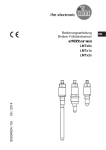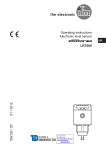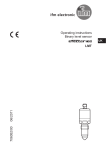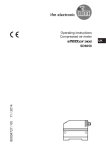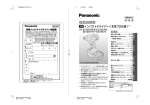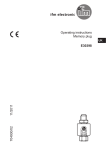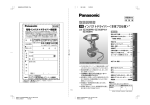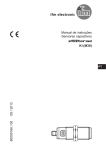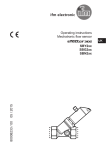Download Operating instructions Binary level sensor
Transcript
Operating instructions Binary level sensor UK 80223649 / 00 10 / 2014 LMTx0x LMTx1x LMTx2x Contents 1 Preliminary note���������������������������������������������������������������������������������������������������3 1.1 Symbols used������������������������������������������������������������������������������������������������3 2 Safety instructions�����������������������������������������������������������������������������������������������3 3 Functions and features����������������������������������������������������������������������������������������4 3.1 Applications���������������������������������������������������������������������������������������������������4 3.2 Restriction of the application area�����������������������������������������������������������������6 4 Function���������������������������������������������������������������������������������������������������������������6 4.1 Measuring principle���������������������������������������������������������������������������������������6 4.2 Processing of the measured signals��������������������������������������������������������������7 4.3 Other features of the unit�������������������������������������������������������������������������������7 4.4 IO-Link�����������������������������������������������������������������������������������������������������������7 4.4.1 General information������������������������������������������������������������������������������7 4.4.2 Device-specific information�������������������������������������������������������������������8 4.4.3 Parameter setting tools�������������������������������������������������������������������������8 4.5 Application examples�������������������������������������������������������������������������������������9 4.5.1 Application examples for unit types with short probe����������������������������9 4.5.2 Application examples for unit types with longer probe������������������������10 4.5.3 Application example installation in existing tuning fork adapters ������� 11 5 Installation��������������������������������������������������������������������������������������������������������� 11 5.1 Installation location / environment��������������������������������������������������������������� 11 5.2 Installation process��������������������������������������������������������������������������������������12 5.2.1 Installation LMT1x0, LMT1x1 and LMT1x2����������������������������������������13 5.2.2 Installation LMT1x4 and LMT1x5�������������������������������������������������������13 5.2.3 Installation LMT2x2 and LMT3x2 in existing tuning fork adapters������15 5.3 Notes on the 3A compliant installation���������������������������������������������������������16 5.4 Note on the use in accordance with EHEDG�����������������������������������������������17 6 Electrical connection������������������������������������������������������������������������������������������18 7 Parameter setting����������������������������������������������������������������������������������������������19 7.1 Parameter setting via PC�����������������������������������������������������������������������������19 7.2 Parameter setting via the memory plug�������������������������������������������������������21 7.3 Parameter setting via the teach input����������������������������������������������������������22 7.3.1 Requirements�������������������������������������������������������������������������������������22 7.3.2 Set to the full vessel���������������������������������������������������������������������������22 2 7.3.3 Changing the output function��������������������������������������������������������������23 7.3.4 Fault during the setting process���������������������������������������������������������23 8 Operation�����������������������������������������������������������������������������������������������������������24 9 Maintenance, repair, disposal����������������������������������������������������������������������������25 10 Notes on the regulation (EC) 1935/2004���������������������������������������������������������25 11 Technical data and scale drawing��������������������������������������������������������������������25 12 Factory setting�������������������������������������������������������������������������������������������������26 UK 1 Preliminary note 1.1 Symbols used ► → Instructions Cross-reference Important note Non-compliance can result in malfunction or interference. Information Supplementary note. 2 Safety instructions • Please read the product description prior to setup of the unit. Ensure that the product is suitable for your application without any restrictions. • If the operating instructions or the technical data are not adhered to, personal injury and/or damage to property can occur. • Improper or non-intended use may lead to malfunctions of the unit or to unwanted effects in your application. That is why installation, electrical connection, set-up, operation and maintenance of the unit must only be carried out by qualified personnel authorised by the machine operator. • In order to guarantee the correct condition of the device for the operating time the device must only be used in media to which the wetted parts are sufficiently resistant (→ Technical data). • The responsibility whether the unit are suitable for the respective application lies with the operator. The manufacturer assumes no liability for consequences 3 of misuse by the operator. Improper installation and use of the units result in a loss of the warranty claims. 3 Functions and features The unit monitors the level of liquid, viscous and powdery media in tanks and pipes. It can be used for limit detection and run-dry protection. The separate setting of two switching thresholds enables the detection of two different media (can be used, for example, for phase separation or differentiation of media). 3.1 Applications • Suitable for food and hygienic areas due to food-grade materials and hygienic installation possibilities. • Detection of almost all media, even extremely adhering (e.g. ketchup) or nonconductive ones (e.g. vegetable oil). • The sensitivity is preset at the factory. Easy setup possible without any programming. The unit can be set so that it is also suitable for the applications of other unit types (→ following table / → 12 Factory setting). • Available process connections: G1/2, G3/4 and G1. • Different probe lengths for various mounting positions and for temperature decoupling (→ 4.5.2). Type Preset 1) LMT100 Aqueous media LMT110 Oils, greases, powders LMT121 Media with low water content LMT102 Aqueous media LMT104 Aqueous media LMT105 Aqueous media LMT202 Aqueous media LMT302 Aqueous media 1 2 Sensitivity 1) Probe Process 2) length connection Low 11 mm G1/2 High 11 mm G1/2 Medium 11 mm G1/2 Low Low Low Low Low 38 mm G1/2 153 mm G1/2 253 mm G1/2 28 mm G3/4, tuning fork contour 38 mm G1, tuning fork contour ) Sensitivity adjustable (→ 7 Parameter setting). ) Probe length measured from conical sealing edge (→ Technical data). 4 EHEDG 3A ● ● ● ● ● ● ● ● ● ● In the following table you can find a selection of tested media and the corresponding recommended unit type. A complete list of media is available at www.ifm.com (see tab "Operating instructions" in the data sheet). Medium Alcohol (40 % vol) Beer Butter (salted / unsalted) Ice cream Grease Honey Yoghurt, plain Non-dairy creamer Ketchup Jam Milk Remoulade Olive oil Cream (30 %) Chocolate (at approx. 40 °C) Water (distilled) Water (tap water) Sugar (granulated sugar) LMTx0x ● ● ○ ○ ○ ○ ● ○ ● ● ● ● ○ ○ ○ ● ● ○ LMTx1x ○ ○ ○ ○ ● ○ ○ ● ○ ○ ○ ○ ● ○ ○ ○ ○ ● LMTx2x ● ● ● ● ○ ● ○ ○ ○ ○ ● ○ ○ ● ● ● ● ○ ● The medium can be detected without the need to change the factory setting (plug & play). ○ The medium can be detected by setting the sensitivity (with IO-Link). UK The above-mentioned details are non-binding reference values. Depending on the composition of the listed media deviations may occur. ►► Always check that the device is suitable for your application without any restrictions! 5 3.2 Restriction of the application area • Not suitable for abrasive media (e.g. quartz sand) and heavy bulk material (e.g. stones). • For use in aggressive media (acids and alkali): ►► Check the compatibility of the product materials beforehand (→ Technical data sheet). • Media which are very inhomogeneous separate from each other thus forming separation layers (e.g. oil layer on water): ►► Check the function by an application test. • Air or gas bubbles in liquid media may lead to unwanted switching operations. ►► Check the function by an application test. If required, adapt the sensitivity or set switching delays → 7 Parameter setting. • Do not expose the probe tip to intensive sun radiation (UV radiation). 4 Function 4.1 Measuring principle The unit operates to the impedance spectroscopy method. It evaluates the electrical behaviour of the media to be monitored in the frequency range between 50 and 200 MHz. An electrical field is generated by the probe tip which is influenced by the level. The various media show characteristic behaviour. Also deposits or foam show significantly different behaviour. When a suitable unit has been selected the presence of certain media is detected, deposits or foam are suppressed. In many cases the factory setting is sufficient. For special applications it is also possible to adapt the sensitivity to the respective application → 7 Parameter setting. 6 4.2 Processing of the measured signals Factory setting Outputs OUT1 / OUT2 complement each other: OUT1 = Hno; OUT2 = Hnc No medium detected OUT1 = OFF OUT2 = ON Medium detected OUT1 = ON OUT2 = OFF The readiness for operation and the switching status are indicated by LEDs → 8 Operation. UK 4.3 Other features of the unit • Food-grade materials • Hygienic installation possibilities without dead band. • Approvals / conformities (→ Technical data sheet) • Indication of the switching status and readiness for operation via LEDs. • After power on the unit is immediately ready for operation; observe the application area of the individual unit types → 3.1 Applications. • Defined position of the cable entry for angled sockets for use of ifm welding adapters. • Streamlined sensor geometry, no blockage of the pipe, no pressure loss. • Orientation-independent installation possible. • On delay and off delay adjustable from 0...10 s. • IO-Link function → 4.4 IO-Link. Some unit types do not feature all indicated characteristics (→ Technical data sheet). 4.4 IO-Link 4.4.1 General information This unit has an IO-Link communication interface which requires an IO-Linkcapable module (IO-Link master) for operation. The IO-Link interface enables direct access to the process and diagnostic data and provides the possibility to set the parameters of the unit during operation. 7 In addition communication is possible via a point-to-point connection with a USB adapter cable. You will find more detailed information about IO-Link at www.ifm.com/de/io-link. 4.4.2 Device-specific information You will find the IODDs necessary for the configuration of the IO-Link unit and detailed information about process data structure, diagnostic information and parameter addresses at www.ifm.com/de/io-link. 4.4.3 Parameter setting tools You will find all necessary information about the required IO-Link hardware and software at www.ifm.com/de/io-link. 8 4.5 Application examples 4.5.1 Application examples for unit types with short probe Example LMT121 Fig. A Fig. B UK 1 1 1 1: Please note the warning! • Fig. A: Installation positions options in a tank (e.g. for point level detection or as run-dry protection). • Fig. B: Fill level monitoring in pipes. In case of strongly adhering and viscous media the installation positions (1) in fig. A and fig. B are only suited to some extent. Residues might be detected as level. 9 4.5.2 Application examples for unit types with longer probe Example LMT104 Fig. C 1: Maximum level Fig. C: Installation from the top to monitor the maximum level (1) or as overfill protection. Different probe lengths enable different response levels. Fig. D Fig. D: Lateral installation, the deeper position in the tank (longer distance between the sensor tip and the tank wall) ensures the suppression of strongly adhering and viscous deposits. The variable clamp fitting (order no. E43322) allows variable mounting for unit types LMT1x4 and LMT1x5. This enables e.g. high-precision adjustment of the response point. Moreover, these types can be thermically decoupled from the process. This also makes applications with higher process temperature and/or with the risk of heat accumulation possible (e.g. tank insulation). Further information: → Technical data sheet E43322 → Operating instructions E43322 10 4.5.3 Application example installation in existing tuning fork adapters Fig. E UK 1: Maximum level Fig. E: Existing tuning fork welding adapters can be used in many cases with the unit types LMT2x2 and LMT3x2 with G3/4 or G1 process connection → 3.1 Applications. Typically, the response point (1) remains in most cases. For use of process connections from other manufacturers: Note the remarks → 5.1 Installation location / environment! If properly installed in the original, hygienic welding adapter, EHEDG and also 3A conformity can be reached. 5 Installation Before installing and removing the unit: Make sure that no pressure is applied to the system and there is no medium in the pipe or the tank. Also always note the potential dangers related to extreme machine and medium temperatures. 5.1 Installation location / environment • Installation preferably in closed metal tanks. 11 When installed in plastic tanks, there may be deterioration caused by electromagnetic interference. ►► Check the function by an application test. ►► If disturbances occur, appropriate measures must be taken (shielding, grounding, etc.). A correct fit and function of the unit and ingress resistance of the connection are only ensured using ifm adapters. Available accessories: www.ifm.com → Data sheet search → Accessories For use of process connections from other manufacturers: ►► Ensure mechanical compatibility. As a rule, ifm does not assume any responsibility for ingress resistance, hygiene and function, in particular with non-existing compatibility, incorrect installation! • Installation in pipes from DN25 possible (for short probes). • When mounted in restricted spaces (e.g. pipes, tank corners) or in agitators: 15 mm ►► To avoid malfunction and damage on sensor and plant, adhere to a distance of min. 15 mm to neighbouring objects (e.g. pipe/tank walls, structures, other LMT sensors) (fig. F). ►► Observe the respective installation depth of the probe in particular with longer probes. Fig. F 15 mm • Do not use any additional sealing material (e.g. PTFE tape). The sensor must be in electrical contact with the metal process connection. • Protect the probe tip against direct sunlight (UV radiation). 5.2 Installation process The unit is installed by means of an adapter. ►► Observe the installation instructions of the adapter used. 12 ►► Ensure cleanliness of the sealing areas. Remove protective packaging only just before mounting. In case of damaged sealing areas replace the unit or the adapter. ►► Weld or install the adapter into the tank / pipe. With clamp adapters etc. the order of the installation steps differs. Observe the notes in the installation instructions of the respective adapter. 5.2.1 Installation LMT1x0, LMT1x1 and LMT1x2 ►► Slide the supplied seal (black O-ring), Fig. G or the green flat seal (without figure) across the thread onto the sensor and/or check for correct position. It seals the gap on the back between the sensor and the adapter. UK Fig. G 1 ►► Only use O-rings that are supplied with the sensor. Unsuitable O-rings can cause problems with ingress resistance: -- O-ring too large: Leakage on the sensor tip (2), Fig. G. -- O-ring too flat: Leakage on the gap on the back between the sensor and the adapter. 2 1: O-ring (supplied with the adapter) 2: Sealing cone / sealing PEEK on metal ►► Slightly grease the thread of the sensor using a lubricating paste which is suitable and approved for the application. ►► Screw the sensor into the adapter and tighten. Max. tightening torque: 20…25 Nm. ►► After installation check the tank / pipe for ingress resistance. 5.2.2 Installation LMT1x4 and LMT1x5 The seal is formed by the flush front of the metal cone (2), Fig. H. 13 As an option, a PEEK sealing ring (3) is available, Fig. I. If the welding adapter is slightly warped or the sealing surface slightly damaged, the use of the PEEK sealing ring is recommended. The PEEK sealing ring is not supplied with the unit; it can be ordered separately. Order no.: E43323. Fig. H 1: Green flat seal 2: Metal sealing cone Fig. I 3: PEEK sealing, beige 4: Black flat seal Installation using the metal sealing cone fig. H (2) ►► Insert the green flat seal (1) and/or check its position. It seals the gap on the back between the sensor and the adapter. ►► Slightly grease the thread of the sensor using a lubricating paste which is suitable and approved for the application. ►► Screw the sensor into the adapter and tighten. Max. tightening torque: 20…25 Nm. ►► After installation check the tank / pipe for ingress resistance. Installation using the PEEK seal E43323, fig. I ►► Replace the green flat seal (1) with the black flat seal (4). The flat seal (4) is supplied with the article order no. E43323! ►► Slide the PEEK seal (3) onto the sensor tip until the end stop (cone). ►► Slightly grease the thread of the sensor using a lubricating paste which is suitable and approved for the application. 14 ►► Screw the sensor into the adapter and tighten. Max. tightening torque: 20…25 Nm. ►► After installation check the tank / pipe for ingress resistance. 5.2.3 Installation LMT2x2 and LMT3x2 in existing tuning fork adapters Installation in existing tuning fork adapters with flush seal via O-ring → 4.5.3 Application example installation in existing tuning fork adapters. ►► Observe the notes in → 5.1 Installation location / environment for use in process connections of other manufacturers! UK ►► Observe the mounting remarks of the manufacturer of the existing adapter! ►► Insert the green flat seal (1), Fig. J, and/or check its position. It seals the gap on the back between the sensor and the adapter. ►► Slide a suitable, original O-ring and a possibly existing spacing ring of the adapter over the sensor the right way round (G3/4) and/or check the position of the adapter (G1). ►► Check the state and material of the O-ring, replace if necessary. ►► Slightly grease the thread of the sensor using a lubricating paste which is suitable and approved for the application. ►► Screw the sensor into the adapter and tighten at the hexagonal nut (2), Fig. K, until the sensor touches the end stop of the welding adapter (3). Max. tightening torque for the hexagon AF 27 (1), fig. K: 35 Nm. Max. tightening torques for the hexagon*) (2), fig. K: LMT2x2 LMT3x2 *) AF 32 *) AF 36 75 Nm 100 Nm ►► After installation check the tank / pipe for ingress resistance. 15 Fig. J Fig. K 1 2 3 1: Green flat seal 1: Hexagonal nut AF 27 2: Hexagonal nut LMT2x2 AF 32 / LMT3x3 AF 36 3: End stop 5.3 Notes on the 3A compliant installation Some versions of the unit have a 3A approval → 3.1 Applications. It is only valid in conjunction with adapters with 3A approval. Available accessories: www.ifm.com → Data sheet search → Accessories Cannot be used in plants that have to meet the criteria of E1.2 / 63-03 of the 3A standard 63-03. 16 Draining must be ensured by an appropriate installation position (position 1...4). The process connection must be provided with a self-draining leakage port. This is ensured by using the adapter with 3A approval. For use of process connections from other manufacturers observe chapter → 5.1 Installation location / environment. UK 5.4 Note on the use in accordance with EHEDG Depending on the version the unit has an approval in accordance with EHEDG. It is only valid in conjunction with adapters with EHEDG approval (www.ifm.com → Data sheet search → Accessories). For use of process connections from other manufacturers observe chapter → 5.1 Installation location / environment. ►► Make sure that the sensor is integrated into the system in accordance with EHEDG. 17 6 Electrical connection The unit must be connected by a qualified electrician. The national and international regulations for the installation of electrical equipment must be adhered to. Voltage supply to EN 50178, SELV, PELV. ►► Disconnect power. ►► Connect the unit as follows: Normal mode1) 2 1 3 4 1) Teach operation 1 1 2 2 4 4 3 3 Factory setting Pin 1 3 2 (OUT2) 4 (OUT1) Connection Ub+ Ubpnp / npn switching signal •pnp / npn switching signal •IO-Link •Input for teach signal Core colours for ifm sockets Brown Blue White Black Factory setting OUT1 and OUT2: pnp switching signal In the factory setting, the teach operation is deactivated. For activation: → 7.1 Parameter setting via PC → OU1 = Tch • Only output OUT2 is available in the teach mode. Information about available sockets/plugs at www.ifm.com → Connection technology → Sockets. 18 7 Parameter setting When a suitable unit has been selected, the presence of certain media is detected, deposits or foam are suppressed. In many cases the factory setting is sufficient → 3.1 Applications. For special requirements it is possible to adapt the sensitivity and other functions to the application. Splashes, wave movements and air bubbles can be compensated by setting a switching delay, for example. The parameters can be set prior to installation and setup of the unit or while in operation. UK If you change parameters during operation, this will influence the function of the plant. ►► Ensure that there will be no malfunctions in your plant. The following subchapters describe the three different parameter setting options of the unit. 7.1 Parameter setting via PC For parameter setting IO-Link software is necessary (e.g. "LINERECORDER SENSOR" or "ifm Container"). To connect the sensor via the USB interface of a computer, the USB IO-Link interfaces, order no. E30396 or E30390, are available. The program library of the available DTM objects, the IO Device Description (IODD) and the FDT service program "ifm Container" can be downloaded at www.ifm.com → Service → Download. 19 The following parameters can be set: SPx / rPx Sensitivity of the set points (SPx) and reset points (rPx) for outputs OUT1 and OUT2. The values for SPx / rPx are set in per cent of the maximum process value. The process value is defined as follows: Process value in air = 0 % Process value in tap water = 100 % Minimum hysteresis: 2 % Reference values: OUx Aqueous / water-based media: SPx = 62 %, rPx = 54 % (factory setting LMTx0x) Media with low water content: SPx = 35 %, rPx = 29 % (factory setting LMTx2x) Oils, fats, powdery media: SPx = 8 %, rPx = 5 % (factory setting LMTx1x) Output function for OUTx: -- [Hno] = hysteresis function/NO -- [Hnc] = hysteresis function/NC -- [Fno] = window function/NO -- [Fnc] = window function/NC OUT1: -- [Tch] = configure pin 4 as input for the teach signal (→ 6 Electrical connection / → 7.3 Parameter setting via the teach input) TSP1 Teach to medium 1 •Full adjustment to the medium 1 to be detected, automatically sets the switching thresholds SP1 / rP1 for OUT1. TSP2 Teach to medium 2 •Full adjustment to the medium 2 to be detected, automatically sets the switching thresholds SP2 / rP2 for OUT2. FOUx Response of the outputs OUTx in case of a fault. dFo Delay time for switching response in case of a fault. Setting range 0…5 s. Step increment 0.2 s dsx*) Switching delay for OUTx. Setting range 0…10 s. Step increment 0.2 s *) Parameter ds is not available for LMT100, LMT110 and LMT121! 20 The following parameters can be set: drx Switch-off delay for OUTx. Setting range 0…10 s. Step increment 0.2 s P_n Switching logic for the outputs (pnp or npn) rES Restore the factory setting COd 0 Access code for menu level 1 Menu level 1 contains all parameters listed. After activation of this access code the unit is completely protected against unauthorised changes. UK In case of loss of the valid code, parameter setting is not possible! Therefore store the code carefully! COd 1 Access code for menu level 2 Menu level 2 contains the menu items FOU, ds, dr, P_n, dFo, rES and COd. After activation of this access code only these parameters are protected against unauthorised changes. 7.2 Parameter setting via the memory plug Parameters can be set quickly and easily via a correctly set memory plug (order no. E30398). To do so, a suitable parameter set must be loaded to the memory plug (e.g. via a PC). The memory plug can also be used to save the current parameter setting of a unit and to transfer it to other units of the same type. You can find more information about the memory plug in the technical documentation (available free of charge at www.ifm.com). 21 7.3 Parameter setting via the teach input In the teach mode the functionality is restricted, only output OUT2 is available. During teach operation, the LEDs indicate the switching status of output OUT2. 7.3.1 Requirements The teach input must be activated. To do so, there are two options: • Via the IO-Link software → 7.1 Parameter setting via PC. • Via the memory plug → 7.2 Parameter setting via the memory plug. Output OUT2 must be configured as hysteresis function (Hnc or Hno). Another configuration causes an error during the teach process (→ 7.3.4 Fault during the setting process). The teach process itself is carried out by applying Ub+ to pin 4 (→ 6 Electrical connection). The tool which is available for this process is the teach button (order no. E30405). 7.3.2 Set to the full vessel With the full adjustment the sensitivity of the unit can be set to the medium to be detected in an optimum manner (this suppresses deposits and foam): ►► Fill the tank until the probe tip is completely covered. ►► Apply Ub+ to pin 4 for > 2 ... < 5 s (T1). ). >> LEDs flash with 2 Hz ( >> After the teach process, the LEDs light for 2 s; then the colours change to regular operating mode (table → 7.3.3). 22 7.3.3 Changing the output function Output OUT2 can be changed from "NC" (Hnc) to "NO" (Hno) and vice versa. Only the hysteresis functions (Hnc / Hno) are available, the parameters for the window functions can only be set via IO-Link: ►► Apply Ub+ to pin 4 for > 5 ... < 10 s (T1). ), after 5 s it double flashes at 1 Hz ( ). >> LEDs flash with 2 Hz first ( >> After the change, the LEDs light for 2 s; then the colours change to regular operating mode (table below). >> After the change, the LEDs light depending on the level as follows: UK No medium detected Medium detected LEDs = yellow (with Hnc) LEDs = green (with Hnc) LEDs = green (with Hno) LEDs = yellow (with Hno) 7.3.4 Fault during the setting process The teach operation is cancelled in case of a fault: >> LEDs flash green-yellow at 8 Hz. >> The unit returns to the operating mode with unchanged settings. Possible faults: • Time error (teach time too long / too short). • Internal sensor signal outside the measuring range. • Wrong output function: No hysteresis function was selected as output function for OUT2 → 7.3.1 Requirements. • Process value too small (< 9 %, e.g. for powdery media), setting SPx / rPx has to be made manually → 7.1 Parameter setting via PC. 23 8 Operation When the supply voltage has been applied, the unit is in the operating mode. It carries out its evaluation functions and switches the outputs. The following table shows the factory settings. In this state OUT1 = Hno and OUT2 = Hnc. Operating mode Unit ready for operation, no medium detected Unit ready for operation, medium detected No operating voltage Short circuit output 1 Short circuit output 2 Error / failure Teach operation Fault during the setting process 1) According to the level LEDs Green OUT1 OFF OUT2 ON Yellow ON OFF OFF OFF OFF 1) Flashes yellow 1) Flashes yellow OFF OFF → 7.3.2 Set to the full vessel → 7.3.3 Changing the output function LEDs flash green-yellow at 8 Hz In the factory setting, the LEDs indicate the switching status of OUT1 (exception: teach operation → 7.3). 24 9 Maintenance, repair, disposal ►► From time to time check the probe cap for deposits and damage. Clean the unit if badly soiled. In case of damage replace the unit. ►► After removal and before reinstallation of the unit carefully clean the probe neck and the installation slot - especially the sealing cone - with appropriate methods to ensure that it is resistant to ingress and without dead space. ►► If the variable clamp fitting E43322 is used: Check the correct position of the safety chain or the securing wire between the clamp fitting and the sensor from time to time. ►► Replace if damaged! UK When the medium is changed, it may also be necessary to use another type of unit or adapt the sensitivity → 3.1 Applications. ►► It is not possible to repair the unit. ►► After use dispose of the unit in an environmentally friendly way in accordance with the applicable national regulations. ►► In case of returns ensure that the unit is free from soiling, especially of dangerous and toxic substances. For transport only use appropriate packaging to avoid damage of the unit. 10 Notes on the regulation (EC) 1935/2004 The following components of the product are designed for permanent contact with food according to the regulation (EC) 1935/2004: - Sensor tip made of PEEK - Sealing ring made of PEEK (→ 5.2.2) 11 Technical data and scale drawing Technical data and scale drawing at www.ifm.com → Data sheet search → Enter the article number. 25 12 Factory setting LMTx0x LMTx1x LMTx2x SP1 62 % 8 % 35 % rP1 54 % 5 % 29 % OU1 Hno Hno Hno SP2 62 % 8 % 35 % rP2 54 % 5 % 29 % OU2 Hnc Hnc Hnc FOU1 OFF OFF OFF FOU2 OFF OFF OFF ds1 *) 0.0 0.0 0.0 ds2 *) 0.0 0.0 0.0 dr1 0.0 0.0 0.0 dr2 0.0 0.0 0.0 P_n pnp pnp pnp dFo 0.0 0.0 0.0 User setting Percentage values refer to the final value of the process value → 7 Parameter setting *) Parameters not provided with LMT100, LMT110 and LMT121 More information at www.ifm.com 26 UK 27



























